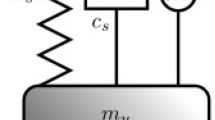Abstract
All adaptive algorithms suffer stability issues when employed for the impulsive noise control under the domain of active noise control (ANC) systems. There is a dire need of investigations to overcome this limitation for the impulsive noise, a robust adaptive algorithm is proposed in literature. In the first part of paper, this robust adaptive algorithm is tested for the first time under ANC environment for impulsive noise cancellation and thus, a new ANC algorithm named filtered-x least cosine hyperbolic (FxLCH) algorithm is presented. Simulations are carried out to validate the improved performance of proposed FxLCH algorithm where the impulsive noise realizations are generated by symmetric α-stable distributions. Moreover, the proposed solutions perform better than the standard filtered-x least mean square (FxLMS) algorithm including its variants, and it shows better stability and converges faster than its competitors. Robustness of the algorithm is a constraint in the presence of high impulsive noise. To overcome this problem and to enhance the robustness of proposed FxLCH algorithm, two modifications are suggested. First proposed modification clips the reference and error signals (CFxLCH algorithm), while the second modification integrates already reported normalized step size with FxLCH (MFxLCH) algorithm. The performance of suggested MFxLCH algorithm is validated by extensive simulations. The results exhibited that MFxLCH algorithm acts as a trade-off between FxLMS and filtered-x recursive least square (FxRLS) family algorithms. It has shown better convergence speed than that of FxLMS family algorithms and can approach steady state error as of FxRLS family with almost same computational complexity as of FxLMS family algorithms.

















Similar content being viewed by others
References
Kuo, S. M., & Morgan, D. R. (1996). Active noise control systems-algorithms and DSP implementation. New York: Wiley.
Elliott, S. J., & Nelson, P. A. (1990). The active control of sound. Journal of Electronics & Communication Engineering,2(4), 127–136.
Akhtar, M. T. (2017). An adaptive algorithm, based on modified tanh non-linearity and fractional processing, for impulsive active noise control systems. Journal of Low Frequency Noise Vibration and Active Control. https://doi.org/10.1177/1461348417725952.
Kajikawa, Y., Gan, W. S., & Kuo, S. M. (2012). Recent advances on active noise control: Open issues and innovative applications. APSIPA Transactions on Signal and Information Processing. https://doi.org/10.1017/ATSIP.2012.4.
Rabie, K., & Alsusa, E. (2014). Preprocessing based impulsive noise reduction for power line communications. IEEE Transactions on Power Delivery,29(4), 1648–1658.
Nikias, C. L., & Shao, M. (1995). Signal processing with alpha-stable distribution and applications. New York: Wiley.
Sun, X., Kuo, S. M., & Meng, G. (2006). Adaptive algorithm for active control of impulsive noise. Journal of Sound and Vibration,291, 516–522.
Akhtar, M. T., & Mitsuhashi, W. (2009). Improving performance of the FxLMS algorithm for active noise control of impulsive noise. Journal of Sound and Vibration,327, 647–656.
Akhtar, M. T., & Mitsuhashi, W. (2010). A modified normalized FxLMS algorithm for active control of impulsive noise. In Proceedings of the EUSIPCO 2010 (pp. 1–5).
Wu, L., He, H., & Qiu, X. (2011). An active impulsive noise control algorithm with logarithmic transformation. IEEE Transaction on Audio, Speech, and Language Process,19(4), 1041–1044.
Bergamasco, M., Della Rossa, F., & Piroddi, L. (2012). Active noise control with on-line estimation of non-Gaussian noise characteristics. Journal of Sound and Vibration,331(1), 27–40.
Li, P., & Yu, X. (2013). Active noise cancellation algorithms for impulsive noise. Mechanical Systems and Signal Processing,36(2), 630–635.
Zhou, Y., Zhang, Q., & Yin, Y. (2015). Active control of impulsive noise with symmetric α-stable distribution based on an improved step-size normalized adaptive algorithm. Mechanical Systems and Signal Processing,56, 320–339.
Huang, B., Xiao, Y. G., Sun, J. W., & Wei, G. (2013). A variable step size FXLMS algorithm for narrowband active noise control. IEEE Transactions on Audio, Speech, and Language Process,21(2), 301–312.
Chang, D. C., & Chu, F. T. (2013). A new variable tap-length and step size FxLMS algorithm. IEEE Signal Processing Letters,20(11), 1122–1125.
Akhtar, M. T. (2015). Binormalized data-reusing adaptive filtering algorithm for active control of impulsive sources. Digital Signal Process,49, 56–64.
Zeb, A., Mirza, A., Khan, Q. U., & Sheikh, S. A. (2017). Improving performance of the FxRLS algorithm for active noise control of impulsive noise. Applied Acoustics,116, 364–374.
Sayed, A. H. (2003). Fundamentals of adaptive filtering. New York: Wiley.
Soria, E., Martin, J. D., Calpe, J., Serrano, A., & Chambers, J. (2006). Robust adaptive algorithm with low computational cost. Electronics Letters,42(1), 2–60.
Soria, E., Martín, J. D., Serrano, A. J., Calpe, J., & Chambers, J. (2007). Steady-state and tracking analysis of a robust adaptive filter with low computational cost. Signal Process,87(1), 210–215.
Zeb, A., Mirza, A., & Sheikh, S. A. (2015). FxRLS algorithm based ANC of impulsive noise. In: Proceedings of the ICMIC 2015 (pp. 18–20).
Kuo, S. M., Panahi, I., Chung, K. M., Horner, T., Nadeski, M., & Chyan, J. (1996). Design of active noise control systems with the TMS320 family. Dallas: Texas Instruments.
Author information
Authors and Affiliations
Corresponding author
Additional information
Publisher's Note
Springer Nature remains neutral with regard to jurisdictional claims in published maps and institutional affiliations.
Rights and permissions
About this article
Cite this article
Mirza, A., Zeb, A., Yasir Umair, M. et al. Less complex solutions for active noise control of impulsive noise. Analog Integr Circ Sig Process 102, 507–521 (2020). https://doi.org/10.1007/s10470-019-01565-0
Received:
Revised:
Accepted:
Published:
Issue Date:
DOI: https://doi.org/10.1007/s10470-019-01565-0




